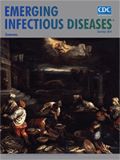
EID Journal Home > Volume 16, Number 12–December 2010
Volume 16, Number 12–December 2010
Dispatch
Proportion of Deaths and Clinical Features in Bundibugyo Ebola Virus Infection, Uganda
Adam MacNeil, Comments to Author Eileen C. Farnon, Joseph Wamala, Sam Okware, Deborah L. Cannon, Zachary Reed, Jonathan S. Towner, Jordan W. Tappero, Julius Lutwama, Robert Downing, Stuart T. Nichol, Thomas G. Ksiazek, and Pierre E. Rollin
Author affiliations: Centers for Disease Control and Prevention, Atlanta, Georgia, USA (A. MacNeil, E.C. Farnon, D.L. Cannon, Z. Reed, J.S. Towner, S.T. Nichol, T.G. Ksiazek, P.E. Rollin); Ministry of Health, Republic of Uganda, Kampala, Uganda (J. Wamala, S. Okware); Global AIDS Program, Centers for Disease Control and Prevention, Entebbe, Uganda (J.W. Tappero, R. Downing); Uganda Virus Research Institute, Entebbe (J. Lutwama); and University of Texas Medical Branch, Galveston, Texas, USA (T.G. Ksiazek)
Suggested citation for this article
Abstract
The first known Ebola hemorrhagic fever (EHF) outbreak caused by Bundibugyo Ebola virus occurred in Bundibugyo District, Uganda, in 2007. Fifty-six cases of EHF were laboratory confirmed. Although signs and symptoms were largely nonspecific and similar to those of EHF outbreaks caused by Zaire and Sudan Ebola viruses, proportion of deaths among those infected was lower (≈40%).
Ebola hemorrhagic fever (EHF) is a severe disease caused by several species of Ebolavirus (EBOV), in the family Filoviridae. Before 2007, four species of EBOV had been identified; 2 of these, Zaire ebolavirus and Sudan ebolavirus, have caused large human outbreaks in Africa, with proportion of deaths ≈80%–90% and 50%, respectively (1–5). Large outbreaks are associated with person-to-person transmission after the virus is introduced into humans from a zoonotic reservoir. Data suggest that this reservoir may be fruit bats (6,7). During outbreaks of EHF, the virus is commonly transmitted through direct contact with infected persons or their bodily fluids (8–11). The onset of EHF is associated with nonspecific signs and symptoms, including fever, myalgias, headache, abdominal pain, nausea, vomiting, and diarrhea; at later stages of disease, overt hemorrhage has been reported in ≈45% of cases (12).
Bundibugyo District is located in western Uganda, which borders the Democratic Republic of Congo. After reports of a mysterious illness in Bundibugyo District, the presence of a novel, fifth EBOV virus species, Bundibugyo ebolavirus (BEBOV), was identified in diagnostic samples submitted to the Centers for Disease Control and Prevention (CDC), Atlanta, Georgia, USA, in November 2007 (13). In response to detection of EBOV, an international outbreak response was initiated. In this report, we summarize findings of laboratory-confirmed cases of BEBOV infection.
full-text:
Bundibugyo Ebola Virus, Uganda | CDC EID
Suggested Citation for this Article
MacNeil A, Farnon EC, Wamala J, Okware S, Cannon DL, Reed Z, et al. Proportion of deaths and clinical features in Bundibugyo Ebola virus infection, Uganda. Emerg Infect Dis [serial on the Internet]. 2010 Dec [date cited].
http://www.cdc.gov/EID/content/16/12/1969.htm
DOI: 10.3201/eid1612.100627
Comments to the Authors
Please use the form below to submit correspondence to the authors or contact them at the following address:
Adam MacNeil, Centers for Disease Control and Prevention, 1600 Clifton Rd NE, Mailstop G14, Atlanta, GA 30333, USA; email: aho3@cdc.gov





















.png)












No hay comentarios:
Publicar un comentario